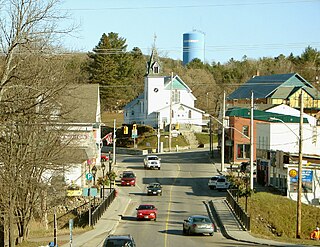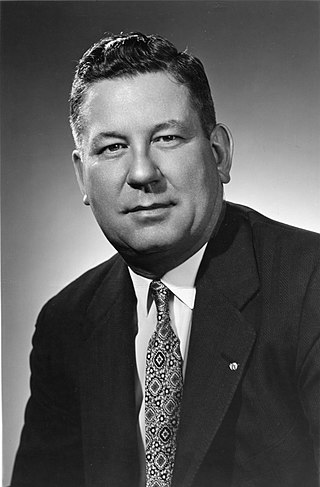
Bancroft is a town located on the York River in Hastings County in the Canadian province of Ontario. It was first settled in the 1850s by United Empire Loyalists and Irish immigrants. From the mid-1950s to about 1982, mining was the primary industry. A village until 1999, Bancroft then merged with Dungannon Township to form the Town of Bancroft. The population at the time of the 2016 Census was 3,881; the regional population is 40,000. There are 150,000 visitors to Bancroft, annually.
The Canadian Red Cross Society is a Canadian humanitarian charitable organization, and one of 192 national Red Cross and Red Crescent societies. The organization receives funding from both private donations and from Canadian government departments.

Wiarton is a community in the town of South Bruce Peninsula, Bruce County, Ontario, Canada. It is located at the western end of Colpoys Bay, an inlet off Georgian Bay, on the Bruce Peninsula.

Loyalist College is an English-language college in Belleville, Ontario, Canada that is partnered with private Toronto Business College.

Highlands East is a township municipality located in Haliburton County, Ontario, Canada.

The Toronto Patriots are a junior "A" ice hockey team from Toronto, Ontario, Canada. They are a part of Ontario Junior Hockey League.
King's Highway 41, commonly referred to as Highway 41, is a provincially maintained highway in the Canadian province of Ontario. The 159.6-kilometre (99.2 mi) highway travels in a predominantly north–south direction across eastern Ontario, from Highway 7 in Kaladar to Highway 148 in Pembroke. The majority of this distance crosses through a rugged forested region known as Mazinaw Country. However, the route enters the agricultural Ottawa Valley near Dacre. A significant portion of Highway 41 follows the historic Addington Colonization Road, built in 1854.

Madawaska Mine (previously known as Faraday Mine) is a decommissioned underground uranium mine in Faraday, near the town of Bancroft, Ontario, which produced 9 million pounds (4,082 tonnes) of U3O8 concentrate, at an average ore grade of 0.1074%, during its two periods of production.

Clarke Tivy Rollins was a politician in Ontario, Canada. He was a Progressive Conservative member of the Legislative Assembly of Ontario from 1959 to 1981 who represented the ridings of Hastings East, Hastings, and Hastings—Peterborough.

The Central Ontario Railway (COR) was a former railway that ran north from Trenton, Ontario to service a number of towns, mines, and sawmills. Originally formed as the Prince Edward County Railway in 1879, it ran between Picton and Trenton, where it connected with the Grand Trunk Railway that ran between Montreal and Toronto. After being purchased by a group of investors and receiving a new charter to build northward, the company was renamed the Central Ontario Railway in 1882, and it started building towards the gold fields at Eldorado and newly discovered iron fields in Coe Hill.

Hastings-Quinte Paramedic Service is a rural ambulance service for Member Municipalities of Hastings County, including the Cities of Belleville and Quinte West, and also under contract to the Prince Edward County and Mohawks of the Bay of Quinte
The Irondale, Bancroft and Ottawa Railway (IB&O) was a short line railway in Central Ontario, Canada. The line was originally opened in 1878 as the Myles Branch Tramway, a horse-drawn wagonway connecting the Snowdon Iron Mine to the Victoria Railway a few miles away. The line was taken over by a group looking to build a northern extension of the Toronto and Nipissing Railway (T&N) as the Toronto and Nipissing Eastern Extension Railway. This extension was never built; instead, the company rechartered as the IB&O and used the Tramway as the basis for a new line with the ultimate aim to connect Orillia to the Ottawa area.
The COVID-19 pandemic is an ongoing viral pandemic of coronavirus disease 2019 (COVID-19), a novel infectious disease caused by severe acute respiratory syndrome coronavirus 2 (SARS-CoV-2). The pandemic has affected the Cities of Mississauga and Brampton, and the Town of Caledon, within the Regional Municipality of Peel. As part of the larger closure decisions in Ontario, a stay-at-home order shuttered all nonessential businesses, and caused event cancellations.

Dyno Mine is a decommissioned underground uranium mine located at Cardiff, near Farrel Lake, approximately 30km southwest of Bancroft, Ontario. It operated from 1958 to 1960.

Uranium mining around Bancroft, Ontario, was conducted at four sites, beginning in the early 1950s and concluding by 1982. Bancroft was one of two major uranium-producing areas in Ontario, and one of seven in Canada, all located along the edge of the Canadian Shield. In the context of mining, the "Bancroft area" includes Haliburton, Hastings, and Renfrew counties, and all areas between Minden and Lake Clear. Activity in the mid-1950s was described by engineer A. S. Bayne in a 1977 report as the "greatest uranium prospecting rush in the world".

The Wilberforce Red Cross Outpost, located in the village of Wilberforce, Ontario is the location of the first Red Cross health post in Ontario. It was designated as a national historic site of Canada in 2003.
Wiarton Hospital is 22-bed rural hospital in Wiarton, Ontario that was opened by the Canadian Red Cross in 1949. The hospital replaced the Wiarton Red Cross Outpost.

Quinte Health Care is a hospital organization that operates four hospitals in Ontario, Canada.
The Fission Mine, previously known as the Richardson Deposit, is a fluoride and uranium deposit in Cardiff, near Wilberforce, Ontario, Canada.













